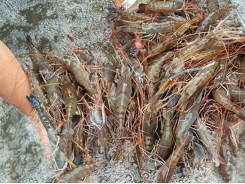Shrimp exports will be positive in 2020

In 2019, although it has not achieved results as expected, Vietnam’s shrimp exports to major markets have showed positive signs for 2020.
The export shrimp production line of Fimex.
According to the Vietnam Association of Seafood Exporters and Producers, Vietnam's shrimp export value was estimated at US$3.38 billion in 2019, down nearly 5 percent compared to 2018. Although it has not achieved expected results , Vietnam’s shrimp exports to major markets showed positive signs for 2020.
In 2019, whiteleg shrimp exports decreased by 3.2 percent, reaching $2.36 billion, accounting for 70 percent of shrimp export value. Black tiger shrimp exports plummeted by 15 percent to$693 million, accounting for 20.5 percent. Exports of marine shrimp products and other shrimp accounted for nearly 10 percent.
In the first half of 2019, shrimp production increased and raw shrimp prices decreased, while shrimp inventories in markets were high. The supply of shrimp from other countries also increased, causing the price of imported shrimp in markets to be lower than 2018. Thereby, shrimp exports continued their downward trend from 2018. Shrimp exports decreased due to the decrease in the first half of the year and the gradual increase in the second half.
The EU is Vietnam's largest shrimp import market, accounting for 20.6 percent of the country’s total shrimp export value. In 2019, Vietnam's shrimp exports to the EU market reached $696.2 million, down 16.9 percent compared to 2018.
The EVFTA Agreement, which is expected to come into effect in 2020, may create high expectations for Vietnam's shrimp exports in the market this year.
According to the EVFTA, the import duty of most raw shrimp (fresh, frozen, chilled shrimp) imported into the EU will be reduced from 12-20 percent to 0 percent right after the agreement comes into effect, and the import duty of processed shrimp will be 0 percent after seven years since the agreement comes into effect.
Regarding the competitive advantage of import duty for the EU compared to other countries, especially for export black tiger shrimp and frozen white leg shrimp, when black tiger shrimp has the GSP tax rate fell from 4.2 percent to 0 percent after the agreement comes into effect, GSP tax rate on frozen white leg shrimp shall gradually reduces to 0 percent after five years while Thailand is not entitled to the GSP, did not sign a FTA and is subject to a basis tax rate of 12 percent; India did not sign a FTA and is subject to GSP of 4.2 percent, Indonesia 4.2 percent, and Ecuador is subject to a basic tax rate of 12 percent.
The income per capita in the EU is high, so products with many facilities will get more interest, the high-end market segment is large, which has enough room for Vietnamese shrimp enterprises to choose the aquatic distribution systems suitable with their supply capacity.
The US ranked second in Vietnam's shrimp imports, accounting for 19.5 percent. In 2019 Vietnam's shrimp exports to the US market were estimated at $646.6 million, up 1.4 percent compared to 2018.
From the beginning of 2019, although growth was not high, Vietnam's shrimp exports to the US maintained stable export value compared to 2018. US demand for shrimp imports from Vietnam in the end of 2019 were higher as the US reduced imports from India and Thailand and sharply reduced imports from China.
In August 2019, the US Department of Commerce (DOC) announced the final result of the 13th administrative review (POR 13) on anti-dumping tax on Vietnamese shrimp to the US for 31 enterprises with a tax rate of 0 percent.
US-China trade tensions have led the US to raise taxes by 25 percent on a lot of goods imported from China, including shrimp products. China’s shrimp exports to the US are more difficult, creating opportunities for China’s competitors in the US market, including Vietnam.
Vietnam's breaded shrimp products were more competitive than China's in the US. In 2019, exports of breaded shrimp products to the US increased 52 percent in volume and 49 percent in value compared to the year before.
Vietnam's shrimp exports to Japan in 2019 were estimated at more than $626 million, down 2 percent compared to 2018. In the structure of shrimp exports to Japan, whiteleg shrimp accounted for 58 percent, black tiger shrimp accounted for 23.4 percent and marine shrimp 18.7 percent.
Shrimp exports to Japan in 2019 only decreased slightly compared to 2018. Trade agreements between Vietnam and Japan aided the partly stable value of Vietnamese shrimp exports to this market.
The 2020 Tokyo Olympics will promote seafood consumption in Japan, especially shrimp, so demand for shrimp is expected to increase, creating opportunities for shrimp exporters across the world.
According to Ho Quoc Luc, Chairman of the Board of Directors of Fimex Vietnam, weather and potential diseases in shrimp farming are still a concern in 2020. Diseases continue because competent authorities have not yet concluded. This risk is a problem; especially as our main shrimp farming area is located in the river basin, where water supply for shrimp farming is full of risks that are difficult to control. Monitoring shrimp breeding and growth process of shrimp together with making medium-term business plans aims to minimise risks. Because in the agriculture field, there are many objective risks.
With the above-mentioned advantages, shrimp exporters are expecting shrimp exports in 2020 will positively increase.
Có thể bạn quan tâm
Phần mềm

Phối trộn thức ăn chăn nuôi

Pha dung dịch thủy canh

Định mức cho tôm ăn

Phối trộn phân bón NPK

Xác định tỷ lệ tôm sống

Chuyển đổi đơn vị phân bón

Xác định công suất sục khí

Chuyển đổi đơn vị tôm

Tính diện tích nhà kính

Tính thể tích ao hồ



 Trà Vinh farmers harvest mud crab for Tết,…
Trà Vinh farmers harvest mud crab for Tết,…  Shrimp exports to Australia rise strongly in 2019
Shrimp exports to Australia rise strongly in 2019